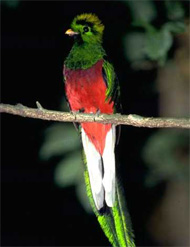 Let’s catch a quetzal—on camera that is. We can begin our hunt by hiking through the Monteverde cloud forest, on a California Native Costa Rica Adventure. If we are lucky, we may see this incredible looking bird winging its way through the sky. With its shimmering emerald green body, red belly, and blue back, the bird does not look real. Adding to this effect is his long flowing blue and green tail, twice as long as his 15 inch body. Truly, the Resplendent Quetzal is one of the most beautiful birds in the world.
Let’s catch a quetzal—on camera that is. We can begin our hunt by hiking through the Monteverde cloud forest, on a California Native Costa Rica Adventure. If we are lucky, we may see this incredible looking bird winging its way through the sky. With its shimmering emerald green body, red belly, and blue back, the bird does not look real. Adding to this effect is his long flowing blue and green tail, twice as long as his 15 inch body. Truly, the Resplendent Quetzal is one of the most beautiful birds in the world.
To the Aztecs and Mayas, the quetzal was their most sacred symbol. Its name was derived from quetzalli, an early Aztec word for the bird’s beautiful tail feathers. The quetzal was a symbol of both freedom and wealth. Freedom, because a quetzal was believed to die in captivity, and wealth, because the Mayas were traders, and quetzal feathers along with jade were their most sought after treasures. They traded the feathers as far north as the central valley of Mexico and as far south as the Empire of the Incas. Only the priests were allowed to wear the feathers of the quetzal. It is said that the feathers were only taken from living birds which were then released to grow new feathers.
A Mayan legend describes how the bird got its crimson breast. When the Mayan chieftain Tecun Uman fell in battle, mortally wounded by the Spanish conquistador Pedro de Alvarado, a gold-and-green quetzal landed on his chest. As the chieftain died, the bird flew off, its breast forever stained with the blood of the Mayan.
During most of the year the quetzals are solitary birds. During breeding season, between March and June, they mate and produce two blue eggs. Both the male and female take turns at incubating the eggs. They feed by darting out of their nests to pluck fruit, insects and occasionally a lizard or frog from the forest canopy.
Originally endangered by local hunters seeking its feathers for religious ceremonies, the quetzal is now threatened by the destruction of its habitat and the demand for its live export.
